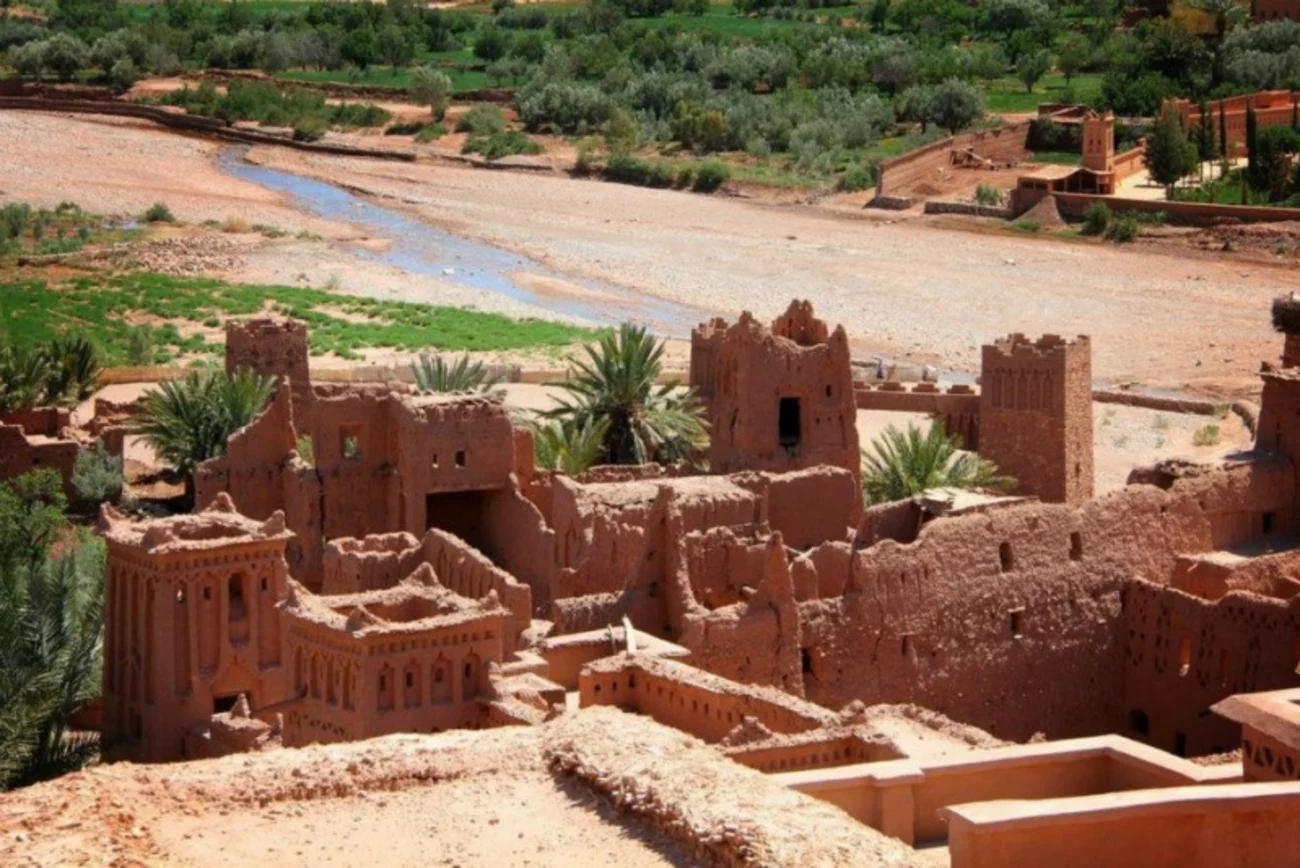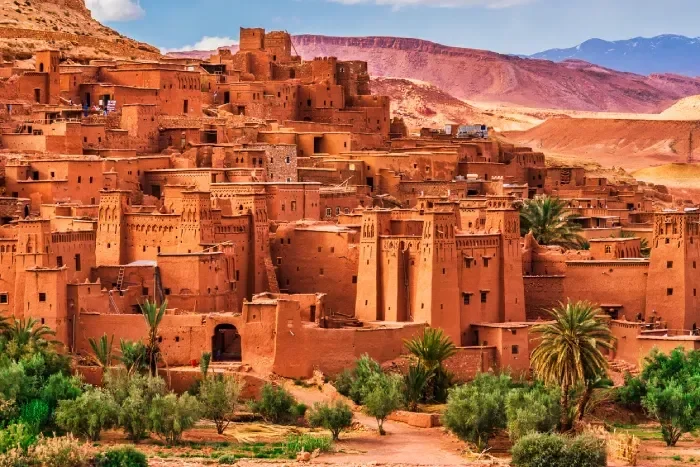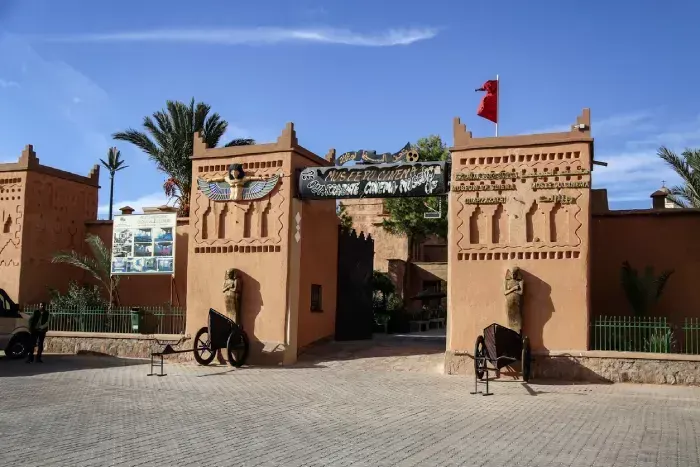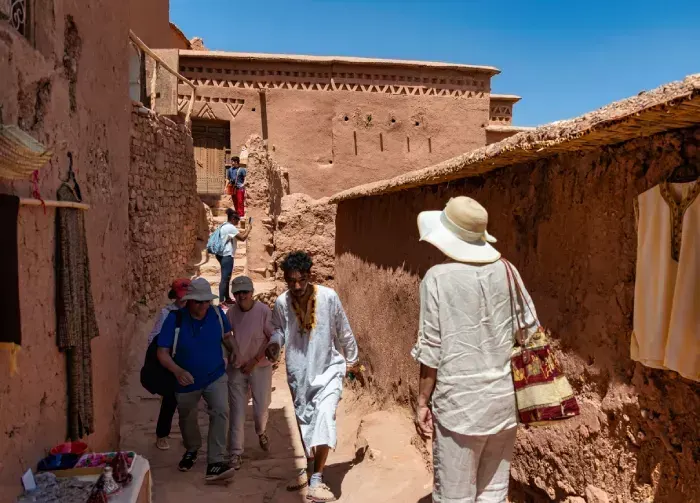Ouarzazate: A Timeless Set Where Morocco's Past Meets Cinematic Future

Picture a place where approximately 70,000 residents call home, which happens to be the largest film studio complex on Earth. This Moroccan desert city holds the remarkable distinction of being the nation's most cinematically connected destination, earning its reputation through decades of hosting world-renowned productions.
Atlas Studios Ouarzazate reveals itself as more than just a filming facility. Entrepreneur Mohamed Belghmi established this cinematic empire in 1983, positioning it merely 5 kilometers from the city center. Here, legendary productions like Gladiator, The Mummy, Aladdin, and Game of Thrones have unfolded across these desert landscapes. What captivates visitors most is the accessibility; a complete studio tour costs under 9 dollars, making this world-class facility surprisingly within reach.
The economic transformation following Atlas Studios' establishment tells a fascinating story of regional development. This once-tranquil desert crossroads now draws celebrated filmmakers like Martin Scorsese, who recognize the unique cinematic potential these landscapes offer. The city has evolved into something extraordinary: a living museum where ancient kasbahs stand alongside Hollywood sets, where traditional Berber architecture provides authentic backdrops for international blockbusters.
This exploration of Ouarzazate will guide you through the layers of discovery that await beyond the famous movie sets, revealing how this desert gem masterfully weaves together centuries-old heritage with modern cinematic artistry.
Ouarzazate's roots: from trade route to film capital
The origin of the name and early history
Deep within the Berber language lies the key to understanding this desert city's essence. "Ouar zazt" translates to "without noise" or "peaceful place"—words that perfectly captured the tranquil nature of this ancient trading post positioned at the Sahara's edge. The settlement emerged as a crucial crossroads where caravans would pause between the Atlas Mountains and the endless desert expanses, creating a natural meeting point for commerce and culture.
Centuries of merchants traversed these harsh landscapes, carrying salt, gold, and aromatic spices from distant corners of Africa. Each caravan that stopped here contributed to the gradual formation of what we know today as Ouarzazate. The kasbahs, those distinctive fortified dwellings, rose from the earth as enduring monuments to this age of trade, their weathered walls holding countless stories of cultural exchange and desert commerce.
French colonial influence and city development
The early 20th century brought dramatic change when French colonial administrators recognized Ouarzazate's strategic importance. French Protectorate rule (1912-1956) marked the beginning of the settlement's transformation from scattered kasbahs into an organized urban center.
Military strategists chose this location for a garrison because of its commanding position where the Draa and Dadès valleys converge. The French understood that controlling this junction meant controlling movement and trade across multiple regions of Morocco. Administrative buildings appeared alongside expanded infrastructure, while French urban planners laid the groundwork for the modern city layout that visitors encounter today.
How Ouarzazate became a desert gateway
Moroccan independence in 1956 opened new possibilities for this desert settlement. The extraordinary landscape, dramatic mountain silhouettes, sweeping plateaus, and proximity to rolling sand dunes created scenery unlike anywhere else on Earth.
Film directors began recognizing this cinematic treasure during the late 1960s. The authentic desert vistas, dependable sunshine, and remarkably diverse terrain offered the perfect solution for productions seeking multiple worldwide locations within a single area. Traditional kasbahs and ksours (fortified villages) provided ready-made historical sets that required no artificial construction.
What happened organically over decades became an official reality when Atlas Studios opened its gates. Ouarzazate's metamorphosis into "Morocco's Hollywood" was complete. The city had successfully evolved from a remote desert outpost into an internationally recognized filming destination, establishing an economic foundation that honors its historical role as a crossroads where cultures and commerce converge.
Plan your Ouarzazate within Morocco Travel Packages Now!

Top things to do in Ouarzazate, Morocco
The cinematic reputation represents just one facet of Ouarzazate's multifaceted character. Beyond the movie sets lies a treasure trove of cultural landmarks, historical monuments, and natural sanctuaries that reveal the authentic soul of this desert crossroads.
Explore Kasbah Taourirt and Ksar Taourirt
Dominating central Ouarzazate's skyline, Kasbah Taourirt emerges as a 17th-century architectural masterpiece that once commanded vital trade routes where multiple river valleys converge. The fortress displays extraordinary earthen construction techniques, its walls adorned with intricate geometric Berber motifs that have weathered centuries of desert winds. Within these fortified walls lie nearly 300 rooms and 20 riads, creating a labyrinthine complex that speaks to the wealth and influence of its original inhabitants.
UNESCO restoration efforts have breathed new life into select sections, allowing contemporary visitors to witness the grandeur that once defined Glaoui family residences. The restored chambers showcase exquisite stucco carvings, vibrant wall paintings, and cedar wood ceilings crafted with remarkable attention to ornamental detail. Each room tells stories of a bygone era when this fortress controlled the economic pulse of southern Morocco's trade networks.
Visit the Cinema Museum
Positioned directly opposite Kasbah Taourirt, the Cinema Museum occupies a structure originally constructed by an Italian film production company in 1981. The facility houses an impressive collection of vintage film sets, authentic movie props, and historical cinematic equipment that chronicle the region's transformation into a global filming destination. Current circumstances have temporarily affected access fire damage in June 2024 has necessitated closure pending investigation. Once reopened, the museum's four primary buildings will again display throne halls, prison cells, torture chambers, and extensive exhibits of vintage cameras and filmmaking apparatus.
Relax at Place Al-mouahidine
Night transforms this central square into a vibrant community theater where local life unfolds in captivating detail. The northern perimeter hosts traditional cafes and restaurants where aromatic tagines simmer while diners observe the authentic rhythms of Ouarzazate society. Evening hours witness remarkable transformations as residents gather for animated conversations over steaming mint tea, young cyclists demonstrate their skills, and children delight in carnival-style rides. This square offers unfiltered access to genuine Moroccan culture, removed from typical tourist circuits.
Discover the Fint Oasis
Twelve kilometers south of the city center, the Fint Oasis conceals itself within the desert landscape, its Berber name literally translates to "hidden," perfectly describing this verdant refuge. Four intimate villages shelter approximately 100 residents among flourishing palm groves that create an almost surreal contrast against the surrounding arid terrain. Hollywood productions have recognized the oasis's cinematic potential, utilizing its dramatic scenery for Prince of Persia and Game of Thrones. The 45-minute journey along unpaved roads requires patience, yet rewards adventurous travelers with stunning agricultural landscapes, traditional village architecture, and tranquil waterways that seem impossible in this desert environment.

Atlas Studios Ouarzazate: where movie magic happens
Desert winds sweep across film sets that have witnessed some of cinema's most memorable moments. This sprawling complex, stretching across vast desert terrain, claims the title of the world's largest film studio by land area. The magic here extends far beyond typical soundstages; entire civilizations have been constructed and preserved across these sun-baked landscapes.
History and founding of the studios
Hollywood's fascination with this region predates the official studio establishment. David Lean's "Lawrence of Arabia" captured desert scenes here in 1962, foreshadowing what would become a cinematic revolution. When Atlas Studios officially opened its gates, the ripple effects created employment opportunities that transformed entire communities. Local residents discovered new livelihoods as extras, set builders, translators, and stuntmen, fundamentally altering the region's economic landscape.
Famous films and series shot here
"The Jewel of the Nile" marked the studio's cinematic debut in 1985, starring Michael Douglas. Timothy Dalton's James Bond escapade "The Living Daylights" followed two years later. However, Ridley Scott's "Gladiator" in 1998 elevated the facility to legendary status, with Russell Crowe's performances earning the city its affectionate "Ouarzawood" moniker. The filmography continues with Martin Scorsese's "Kundun," plus episodes from the epic series that captivated global audiences.
Touring the sets: what to expect
Wandering through these preserved movie worlds offers extraordinary encounters with cinematic history. The Tibetan temple from "Kundun" stands majestically alongside the reconstructed Colosseum, where gladiatorial combat scenes unfolded. Egyptian temples, originally crafted for "Cleopatra," demonstrate the remarkable attention to architectural detail that productions demand. Rather than dismantling these elaborate constructions after filming wraps, the studio maintains them as permanent installations. This preservation philosophy allows future productions to reimagine and repurpose existing sets, creating layers of cinematic history within single structures.
Tips for visiting and guided tours
Access to this cinematic wonderland costs 80 dirhams per person, with guided explorations departing every 20-40 minutes. Film enthusiasts seeking deeper immersion can purchase expanded tickets for 110 dirhams, which include access to additional "Kingdom of Heaven" locations. Operating hours extend from 8:30 AM until sunset throughout the year, regardless of holidays. Spontaneous visits work perfectly, no reservations required. Lucky visitors might even witness active film crews at work, adding real-time movie magic to their desert adventure.
Plan your amazing Ouarzazate and Ait Ben Haddou from Marrakech now!

Customize Your Dream Vacation!
Get in touch with our local experts for an unforgettable journey.
Plan Your TripBeyond the screen: how cinema shaped the city
Cinema's influence radiates outward from Atlas Studios like ripples across water, fundamentally altering Ouarzazate's economic landscape and cultural identity across multiple decades.
Jobs and opportunities for locals
The film industry generates thousands of employment opportunities throughout the region, creating a web of economic activity that reaches far beyond the studio gates. Residents from Ouarzazate and neighboring villages discover work as extras, technicians, drivers, and set builders. The industry's maturation becomes evident through a remarkable statistic: approximately 80% of movie personnel are now Moroccan, representing a dramatic shift from the early days of foreign-dominated productions.
NBC's "A.D. The Bible Continues" exemplifies this local integration—the 2014 production engaged roughly 600 regional artisans for six months. The opportunities extend to unexpected corners of daily life. Taxi drivers can earn around $25 daily plus meals working as extras, while local barbers supplement their income with $50-per-day hair and makeup assignments. These varied income streams demonstrate how cinema weaves itself into the fabric of everyday economic life.
Cultural pride and global recognition
UNESCO's designation of Ouarzazate as a Creative City of Film acknowledges the industry's role in spurring local development and social inclusion. The city accommodates between 15 and 20 film productions annually, cementing its status as a cinematic epicenter for the broader region. This international recognition cultivates profound cultural pride among residents, who witness their homeland transformed into the backdrop for global entertainment phenomena.
The rise of film tourism
Cinematic recognition has sparked a tourism renaissance throughout Ouarzazate. Hotel occupancy surged by 40% in early 2022 compared to the previous year, reflecting growing visitor interest in film-related experiences. The Cinema Museum serves as a repository for film heritage, displaying props, costumes, and memorabilia from regional productions. International film investments exceeded $100 million in Morocco during 2022 alone, with individual productions such as "Gladiator 2" contributing approximately $30 million to local economic activity.
Nearby cinematic landmarks: Ait Ben Haddou and Skoura
Ait Ben Haddou stands 30 kilometers from Ouarzazate as a UNESCO World Heritage Site showcasing traditional earthen architecture. This fortified village has hosted over 20 productions, including "Gladiator" and "Game of Thrones". Skoura's palm groves create another dimension to the region's cinematic appeal, harboring nearly one million palm trees and approximately 100 kasbahs. Kasbah Amridil represents perhaps Skoura's most recognizable structure, featured prominently on Morocco's 50-dirham banknote and established as an iconic filming destination in its own right.
Conclusion
Few places on Earth demonstrate such perfect harmony between historical significance and contemporary innovation as Ouarzazate achieves. This desert crossroads has managed something quite extraordinary: preserving its fundamental identity as a trading hub while welcoming an entirely different kind of commerce—the business of storytelling through cinema.
The architectural marvels speak volumes about this achievement. Kasbah Taourirt's 300-room complex continues to display centuries-old Berber craftsmanship, its geometric patterns and cedar wood ceilings bearing witness to the Glaoui dynasty's influence. These same walls now provide authentic backdrops for international productions, creating a seamless blend where historical preservation serves modern artistic expression.
Cinema's impact reaches deep into the community fabric. Residents who once depended solely on traditional occupations now find themselves part of a global industry, working as extras, artisans, and technicians on major productions. This shift has generated economic vitality while allowing locals to showcase their cultural heritage to worldwide audiences.
The phenomenon extends beyond studio boundaries. Visitors arrive seeking famous filming locations but encounter something richer: authentic Moroccan experiences that unfold naturally. Evening gatherings at Place Al-mouahidine reveal local customs unchanged by Hollywood's presence, while nearby UNESCO sites like Ait Ben Haddou demonstrate how heritage preservation and film tourism can mutually reinforce each other's objectives.
What emerges from this exploration is a profound understanding of adaptation without abandonment. Ouarzazate exemplifies how communities can embrace new opportunities while maintaining their essential character. The city continues evolving, each film production adding another layer to its story while the ancient foundations remain solid beneath the surface.
This desert gateway has written a unique chapter in cultural geography—one where tradition and innovation dance together across the same stage, creating something neither could achieve alone.
FAQs
Q1. What makes Ouarzazate a unique destination in Morocco?
Ouarzazate is known as "Morocco's Hollywood" due to its massive film studios and numerous movie productions. It combines ancient Moroccan architecture with modern filmmaking, offering visitors a chance to explore historic kasbahs and famous movie sets in one location.
Q2. Can tourists visit the film studios in Ouarzazate?
Yes, tourists can visit Atlas Studios, the largest film studio in the world by land area. Tours are available daily, costing around 80 dirhams (approximately $9) per person. Visitors can explore sets from famous movies like "Gladiator" and "The Mummy."
Q3. What are some must-see attractions in Ouarzazate besides the film studios?
Key attractions include the 17th-century Kasbah Taourirt, the vibrant Place Al-mouahidine square, and the lush Fint Oasis. The Cinema Museum, when reopened, offers a glimpse into the city's cinematic history through props and equipment displays.
Q4. How has the film industry impacted Ouarzazate's economy?
The film industry has significantly boosted Ouarzazate's economy by creating thousands of jobs for locals as extras, technicians, and artisans. It has also led to a rise in tourism, with hotels reporting increased occupancy rates due to film-related visits.
Q5. Are there any notable filming locations near Ouarzazate?
Yes, the UNESCO World Heritage Site of Ait Ben Haddou, located 30 kilometers from Ouarzazate, is a popular filming location. This fortified village has appeared in over 20 productions, including "Game of Thrones" and "Gladiator." Additionally, the palm groves of Skoura, with its numerous kasbahs, have also been featured in various films.


































